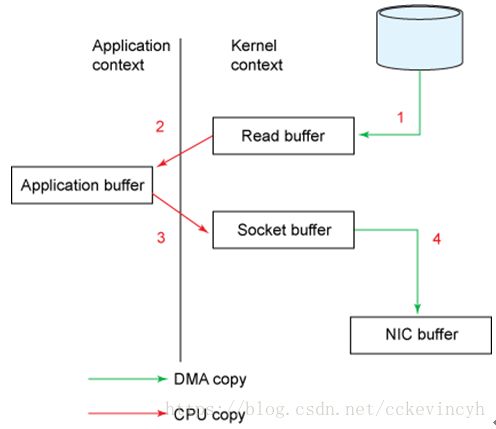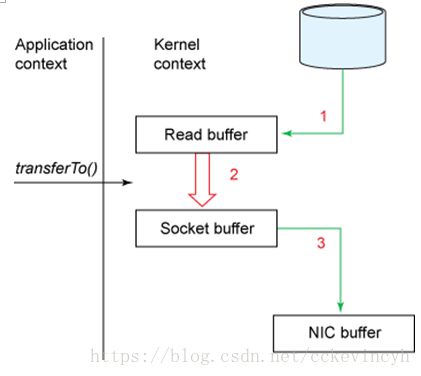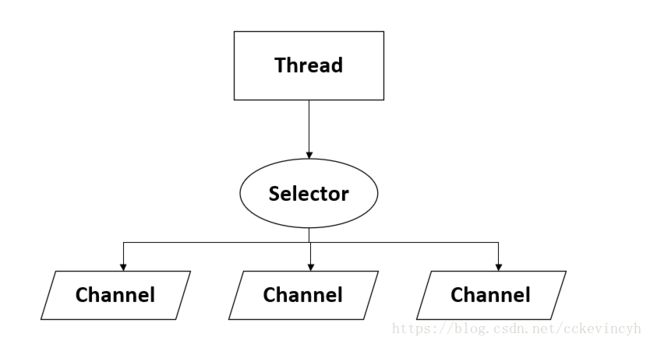NIO的原理介绍和Java示例代码
NIO简介
nio 是New IO 的简称,在jdk1.4 里提供的新api 。Sun 官方标榜的特性如下: 为所有的原始类型提供(Buffer)缓存支持。字符集编码解码解决方案。 Channel :一个新的原始I/O 抽象。 支持锁和内存映射文件的文件访问接口。 提供多路(non-bloking) 非阻塞式的高伸缩性网络I/O 。
传统IO与NIO的区别
传统的I/O
使用传统的I/O程序读取文件内容, 并写入到另一个文件(或Socket), 如下程序:
File.read(fileDesc, buf, len);
Socket.send(socket, buf, len);会有较大的性能开销, 主要表现在一下两方面:
1. 上下文切换(context switch), 此处有4次用户态和内核态的切换
2. Buffer内存开销, 一个是应用程序buffer, 另一个是系统读取buffer以及socket buffer
其运行示意图如下

1) 先将文件内容从磁盘中拷贝到操作系统buffer
2) 再从操作系统buffer拷贝到程序应用buffer
3) 从程序buffer拷贝到socket buffer
4) 从socket buffer拷贝到协议引擎.
NIO
NIO技术省去了将操作系统的read buffer拷贝到程序的buffer, 以及从程序buffer拷贝到socket buffer的步骤, 直接将 read buffer 拷贝到 socket buffer。java 的 FileChannel.transferTo() 方法就是这样的实现, 这个实现是依赖于操作系统底层的sendFile()实现的.
public void transferTo(long position, long count, WritableByteChannel target);他的底层调用的是系统调用sendFile()方法
sendfile(int out_fd, int in_fd, off_t *offset, size_t count);如下图

nio的优势不在于数据传送的速度,而是性能开销更小。
Socket/NIO原理
阻塞与非阻塞
阻塞与非阻塞:阻塞与非阻塞是进程在访问数据的时候,数据内是否准备就绪的一种处理方式。
当数据没有准备好的时候会出现阻塞和非阻塞两种情况。
阻塞:往往需要等待缓冲区中的数据准备好之后才能处理其他的事情,否则一直等待在哪里
非阻塞:当我们的进程访问我们的数据缓冲区的时候,数据没有准备好的时候,直接返回,不需要等待,数据有的时候也直接返回。
同步和异步
同步和异步都是基于应用程序和操作系统处理IO事件所采用的方式:
同步:应用程序要直接参与IO事件的操作;
异步:所有的IO读写事件交给操作系统去处理;
同步的方式在处理IO事件的时候,必须阻塞在某个方法上面等待我们的IO事件完成(阻塞在IO事件或者通过轮询IO事件的方式)了对于异步来说,所有的IO读写操作都交给操作系统,这个时间,我们可以去做其他的时间,并不需要去完成真正的IO操作。当操作系统完成IO之后,给我们的应用程序一个通知就可以了。
同步有两种实现模式:
1.阻塞到IO事件,阻塞到read或者write方法上,这个时候我们就完全不能做自己的事情(在这种情况下,我们只能把读写方法放置到线程中,然后阻塞线程的方式来实现并发服务,对线程的性能开销比较大)
2.IO事件的轮询 ——在linux C语言编程中叫做多路复用技术(select模式)
读写事件交给一个专门的线程去处理,这个线程完成IO事件的注册功能,还有就是不断地去轮询我们的读写缓冲区(操作系统),看是否有数据准备好,然后通知我们的相应的业务去处理线程。这样的话,我们的业务线程就可以去做其他的事情。在这种模式下,阻塞的不是所有的IO线程,而是阻塞的只是select线程。

NIO的三大核心
NIO三大核心部分:Channel(通道),Buffer(缓冲区),Selector(选择器)
Buffer:容器对象, 包含一些要写入或者读出的数据。在NIO库,所有数据都是用缓冲区处理的。在读取数据时,它是直接读到缓冲区中的;在写入数据时,也是写入缓冲区中。任何时候访问NIO的数据,都是通过缓冲区信息操作。
Channel:通道对象,对数据的读取和写入要通过Channel,它就像水管一样。通道不同于流的地方就是通道是双向的,可以同于读、写和同时读写操作。Channel不会直接处理字节数据,而是通过Buffer对象来处理数据。
Selector:多路复用器,选择器。提供选择已经就绪的任务的能力。Selector会不断轮询注册在其上的Channel,如果某个Channel上面发送读或者写事件,这个Channel就处于就绪状态,会被Selector轮询出来,进行后续的I/O操作。这样服务器只需要一两个线程就可以进行多客户端通信。

NIO的Java代码实现
服务端:
package cn.itcast.bigdata.nio;
import java.io.IOException;
public class TimeServer {
/**
* @param args
* @throws IOException
* @author blackcoder
*/
public static void main(String[] args) throws IOException {
int port = 8080;
if (args != null && args.length<0) {
try {
port = Integer.valueOf(args[0]);
} catch (NumberFormatException e) {
// 采用默认值
}
}
MultiplexerTimeServer timeServer = new MultiplexerTimeServer(port);
new Thread(timeServer, "NIO-MultiplexerTimeServer-001").start();
}
}
package cn.itcast.bigdata.nio;
import java.io.IOException;
import java.net.InetSocketAddress;
import java.nio.ByteBuffer;
import java.nio.channels.SelectionKey;
import java.nio.channels.Selector;
import java.nio.channels.ServerSocketChannel;
import java.nio.channels.SocketChannel;
import java.util.Iterator;
import java.util.Set;
public class MultiplexerTimeServer implements Runnable {
private Selector selector;
private ServerSocketChannel servChannel;
private volatile boolean stop;
/**
* 初始化多路复用器、绑定监听端口
*
* @param port
*/
public MultiplexerTimeServer(int port) {
try {
//打开一个多路复用器
selector = Selector.open();
//创建一个socket channel:channel是nio中对通信通道的抽象,部分入站出站方向
servChannel = ServerSocketChannel.open();
//设置通道为非阻塞
servChannel.configureBlocking(false);
//将通道绑定在服务器的ip地址和某个端口上
servChannel.socket().bind(new InetSocketAddress(port), 1024);
//将上面创建好的socket channel注册到selector多路复用器上
//对于服务端来说,一定要先注册一个OP_ACCEPT事件用来响应客户端的请求连接
servChannel.register(selector, SelectionKey.OP_ACCEPT);
System.out.println("The time server is start in port : " + port);
} catch (IOException e) {
e.printStackTrace();
System.exit(1);
}
}
public void stop() {
this.stop = true;
}
/*
* (non-Javadoc)
*
* @see java.lang.Runnable#run()
*/
@Override
public void run() {
while (!stop) {
try {
//去询问一次selector选择器
selector.select(1000);
Set selectedKeys = selector.selectedKeys();
Iterator it = selectedKeys.iterator();
SelectionKey key = null;
while (it.hasNext()) {
//遍历到一个事件key
key = it.next();
it.remove();//确保不重复处理
try {
//处理事件
handleInput(key);
} catch (Exception e) {
if (key != null) {
key.cancel();
if (key.channel() != null)
key.channel().close();
}
}
}
} catch (Throwable t) {
t.printStackTrace();
}
}
// 多路复用器关闭后,所有注册在上面的Channel和Pipe等资源都会被自动去注册并关闭,所以不需要重复释放资源
if (selector != null)
try {
selector.close();
} catch (IOException e) {
e.printStackTrace();
}
}
private void handleInput(SelectionKey key) throws IOException {
if (key.isValid()) {
// 处理新接入的请求消息
if (key.isAcceptable()) {
// Accept the new connection
ServerSocketChannel ssc = (ServerSocketChannel) key.channel();
SocketChannel sc = ssc.accept();//接受连接请求
sc.configureBlocking(false);
// Add the new connection to the selector
sc.register(selector, SelectionKey.OP_READ);
}
if (key.isReadable()) {
// Read the data
SocketChannel sc = (SocketChannel) key.channel();
ByteBuffer readBuffer = ByteBuffer.allocate(1024);
//当客户端channel关闭之后,会不断受到read事件,但没有消息,即read方法返回-1
//所以这时服务器也需要关闭channel,避免无限处理
int readBytes = sc.read(readBuffer);
if (readBytes > 0) {
//一定需要调用flip函数,否则读取错误数据
//简单来说,flip操作就是让读写指针、limit指针复位到正确的位置
readBuffer.flip();
byte[] bytes = new byte[readBuffer.remaining()];
readBuffer.get(bytes);
String body = new String(bytes, "UTF-8");
System.out.println("The time server receive order : "
+ body);
String currentTime = "QUERY TIME ORDER"
.equalsIgnoreCase(body) ? new java.util.Date(
System.currentTimeMillis()).toString()
: "BAD ORDER";
doWrite(sc, currentTime);
} else if (readBytes < 0) {
// 对端链路关闭
key.cancel();
sc.close();
} else
; // 读到0字节,忽略
}
}
}
private void doWrite(SocketChannel channel, String response)
throws IOException {
if (response != null && response.trim().length() > 0) {
byte[] bytes = response.getBytes();
ByteBuffer writeBuffer = ByteBuffer.allocate(bytes.length);
writeBuffer.put(bytes);
writeBuffer.flip();
channel.write(writeBuffer);
}
}
}
客户端:
package cn.itcast.bigdata.nio;
public class TimeClient {
/**
* @param args
*/
public static void main(String[] args) {
int port = 8080;
if (args != null && args.length > 0) {
try {
port = Integer.valueOf(args[0]);
} catch (NumberFormatException e) {
// 采用默认值
}
}
new Thread(new TimeClientHandle("127.0.0.1", port), "TimeClient-001")
.start();
}
}
package cn.itcast.bigdata.nio;
import java.io.IOException;
import java.net.InetSocketAddress;
import java.nio.ByteBuffer;
import java.nio.channels.SelectionKey;
import java.nio.channels.Selector;
import java.nio.channels.SocketChannel;
import java.util.Iterator;
import java.util.Set;
public class TimeClientHandle implements Runnable {
private String host;
private int port;
private Selector selector;
private SocketChannel socketChannel;
private volatile boolean stop;
public TimeClientHandle(String host, int port) {
this.host = host == null ? "127.0.0.1" : host;
this.port = port;
try {
selector = Selector.open();
socketChannel = SocketChannel.open();
socketChannel.configureBlocking(false);
} catch (IOException e) {
e.printStackTrace();
System.exit(1);
}
}
/*
* (non-Javadoc)
*
* @see java.lang.Runnable#run()
*/
@Override
public void run() {
try {
doConnect();
} catch (IOException e) {
e.printStackTrace();
System.exit(1);
}
while (!stop) {
try {
selector.select(1000);
Set selectedKeys = selector.selectedKeys();
Iterator it = selectedKeys.iterator();
SelectionKey key = null;
while (it.hasNext()) {
key = it.next();
it.remove();
try {
handleInput(key);
} catch (Exception e) {
if (key != null) {
key.cancel();
if (key.channel() != null)
key.channel().close();
}
}
}
} catch (Exception e) {
e.printStackTrace();
System.exit(1);
}
}
// 多路复用器关闭后,所有注册在上面的Channel和Pipe等资源都会被自动去注册并关闭,所以不需要重复释放资源
if (selector != null)
try {
selector.close();
} catch (IOException e) {
e.printStackTrace();
}
}
private void doConnect() throws IOException {
// 如果直接连接成功,则注册到多路复用器上,发送请求消息,读应答
if (socketChannel.connect(new InetSocketAddress(host, port))) {
socketChannel.register(selector, SelectionKey.OP_READ);
doWrite(socketChannel);
} else
socketChannel.register(selector, SelectionKey.OP_CONNECT);
}
private void doWrite(SocketChannel sc) throws IOException {
byte[] req = "QUERY TIME ORDER".getBytes();
ByteBuffer writeBuffer = ByteBuffer.allocate(req.length);
writeBuffer.put(req);
writeBuffer.flip();
sc.write(writeBuffer);
if (!writeBuffer.hasRemaining())
System.out.println("Send order 2 server succeed.");
}
private void handleInput(SelectionKey key) throws IOException {
if (key.isValid()) {
// 判断是否连接成功
SocketChannel sc = (SocketChannel) key.channel();
if (key.isConnectable()) {
if (sc.finishConnect()) {
sc.register(selector, SelectionKey.OP_READ);
doWrite(sc);
} else
System.exit(1);// 连接失败,进程退出
}
if (key.isReadable()) {
ByteBuffer readBuffer = ByteBuffer.allocate(1024);
int readBytes = sc.read(readBuffer);
if (readBytes > 0) {
readBuffer.flip();
byte[] bytes = new byte[readBuffer.remaining()];
readBuffer.get(bytes);
String body = new String(bytes, "UTF-8");
System.out.println("Now is : " + body);
this.stop = true;
} else if (readBytes < 0) {
// 对端链路关闭
key.cancel();
sc.close();
} else
; // 读到0字节,忽略
}
}
}
}


